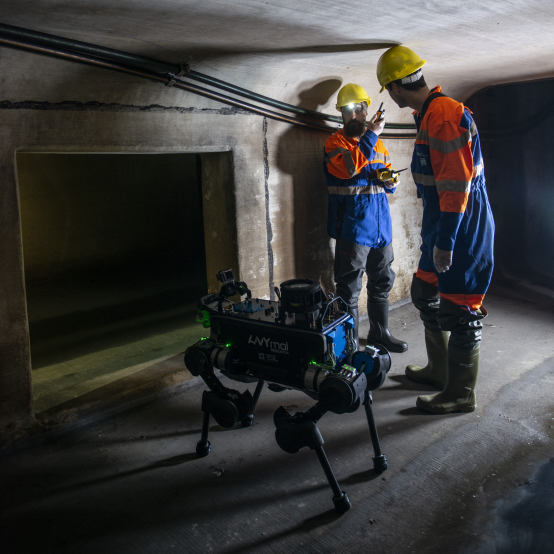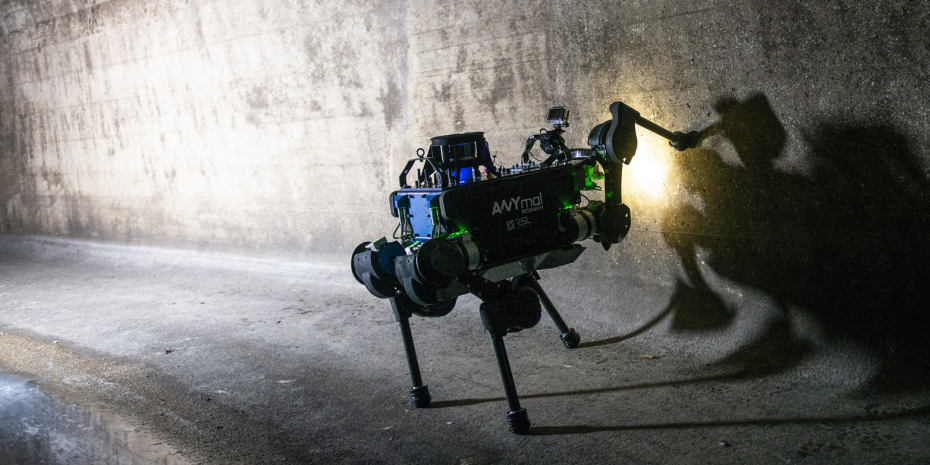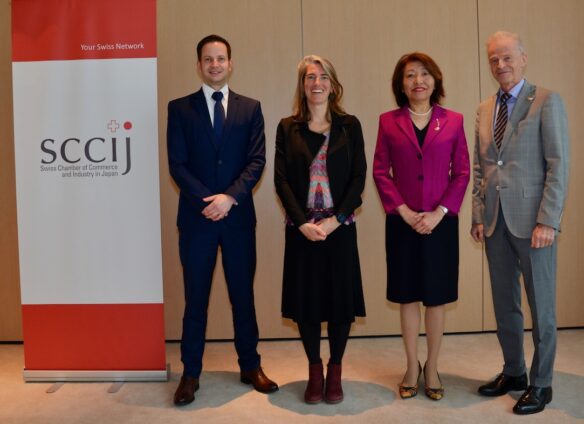Tokyo (SCCIJ) – Switzerland continues to be at the cutting edge of robot research. The latest proof is ANYmal, a robot developed at the Swiss Federal Institute of Technology Zurich (ETH Zurich). It can see and hear, and even open doors. An international research team is now working to ensure that the 30-kilogram high-tech machine jointly developed by Robotic Systems Lab and ANYbotics, an ETH spin-off, can function in extreme conditions. This mission has taken them to the labyrinth of drains and tunnels below Zurich, four meters below the surface.
Finding its way in the dark
The goal of the three-year research project entitled THING (sub-Terranean Haptic InvestiGator) is to design robots that can move about on their own and are better able to identify their surroundings. Robots generally use 3D cameras and laser sensors for orientation. But such devices can malfunction in adverse conditions – such as when the ground surface is wet or the air full of dust. That’s why the researchers now experiment with enhanced haptic perception – orientation by touch – as a possible solution. The project has brought together ETH researchers with colleagues from universities in Edinburgh, Pisa, Oxford and Poznań.

ANYmal on its first tour of inspection in Zurich’s sewerage system
All these institutions are experimenting with ANYmal robots, and the project participants from the various locations meet up on a regular basis. In addition to the tests in the sewerage system, this year the researchers will deploy the robot in a Polish copper mine. That will determine whether it can function in an entirely different microclimate, one characterized by hot, dusty air and gravel surfaces. ETH is represented in the project by the Laboratory for Robotic Systems led by Professor Marco Hutter, who has been conducting research into legged robots for many years. He received support from ETH soon after embarking on this research in the form of an ESOP scholarship and a fellowship of the Japanese company Pioneer.
Underground mission in Zurich
The aim of the testing in Zurich’s underground was to determine whether ANYmal could one day be deployed in sewerage systems. It might be used, for instance, to help the City of Zurich employees who regularly have to walk or crawl through some 100 kilometers of accessible shafts and drains underneath the city and whose job it is to check the walls and floors for damage. This work not only poses a health risk, but is also potentially lethal, given that the drains can fill up with water quickly without warning. Another advantage of robots in such an environment is that they could operate in narrow sewers that cannot be accessed with the technology in use today.
One of the key questions on the first day of testing was whether the robot could find its way around at all in the darkness of the sewerage system. Initially, two helpers with big LED lamps illuminated the surroundings so that they could clearly see what was going on. Then, Peter Fankhauser, co-founder of the ETH spin-off that is commercializing ANYmal, asked the helpers to turn off the lamps and radioed his colleagues on the surface to tell the robot to use its own lights. The robot’s sense of touch isn’t the only thing that helps it find its way in the dark, as Hutter explained: “The robot uses laser sensors and cameras to scan its surroundings. By identifying irregularities in the surface of the concrete, it can determine where it is at any given moment.”

ANYmal can enter spaces too small for humans
Almost ten years of research
Researchers at ETH have been working on quadrupedal robots since 2009. The first ANYmal prototype was completed in 2015 and, one year later, ETH established the spin-off ANYbotics. The fledgling company’s mission is to make robots deployable in all types of terrain so that they can be used in a wide range of practical applications. The company’s slogan is “Let Robots Go Anywhere”. On-site tests are carried out two or three times a month. For instance, Fankhauser and some members of his team recently headed to an offshore platform in the middle of the North Sea. The hope is that robots could one day perform inspections on such platforms. On its pilot run at least, ANYmal autonomously completed several inspection routes with flying colors.
After almost ten years of research, there’s a lot ANYmal can do. It can not only walk autonomously, but also boast the sensory capabilities of sight, hearing and touch. These enable it, for instance, to read the air pressure display on a machine, identify sounds and recognize objects – for example to determine whether or not a fire extinguisher is in the right place. The robot can even perform certain manual tasks on its own. Equipped with an additional gripping arm, it can open doors, dispose of refuse or press a lift button. It also delivers data that is more precise than our own eyes, ears and noses can perceive. It can identify the ambient temperature and detect the presence of gases in the air. Its latest trick is recognizing the composition of the ground beneath it. “Some of its powers are superhuman,” says Fankhauser.
Text: © ETH Zurich/Andres Eberhard edited by SCCIJ; Photos: © ETH Zurich/Daniel Winkler





























